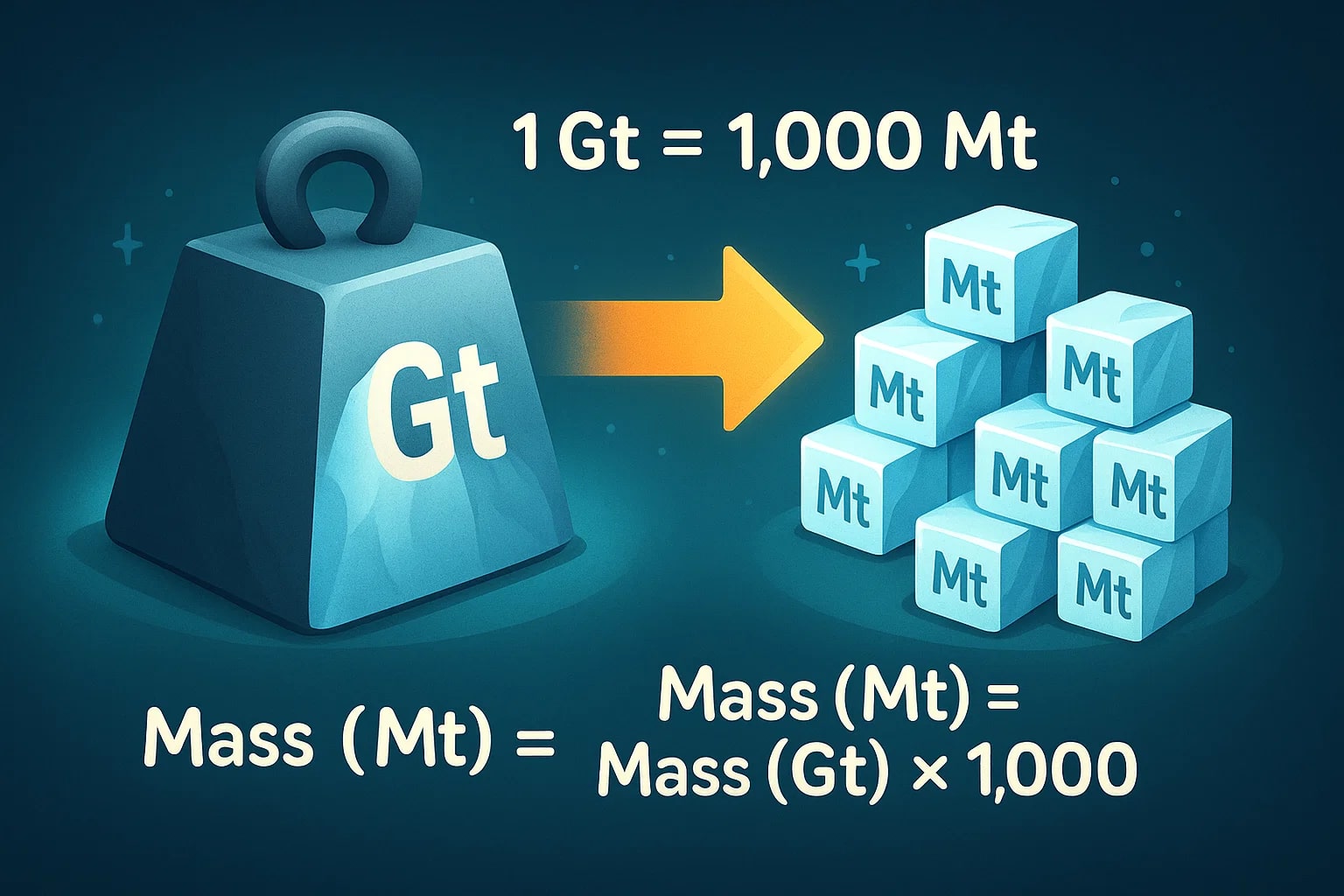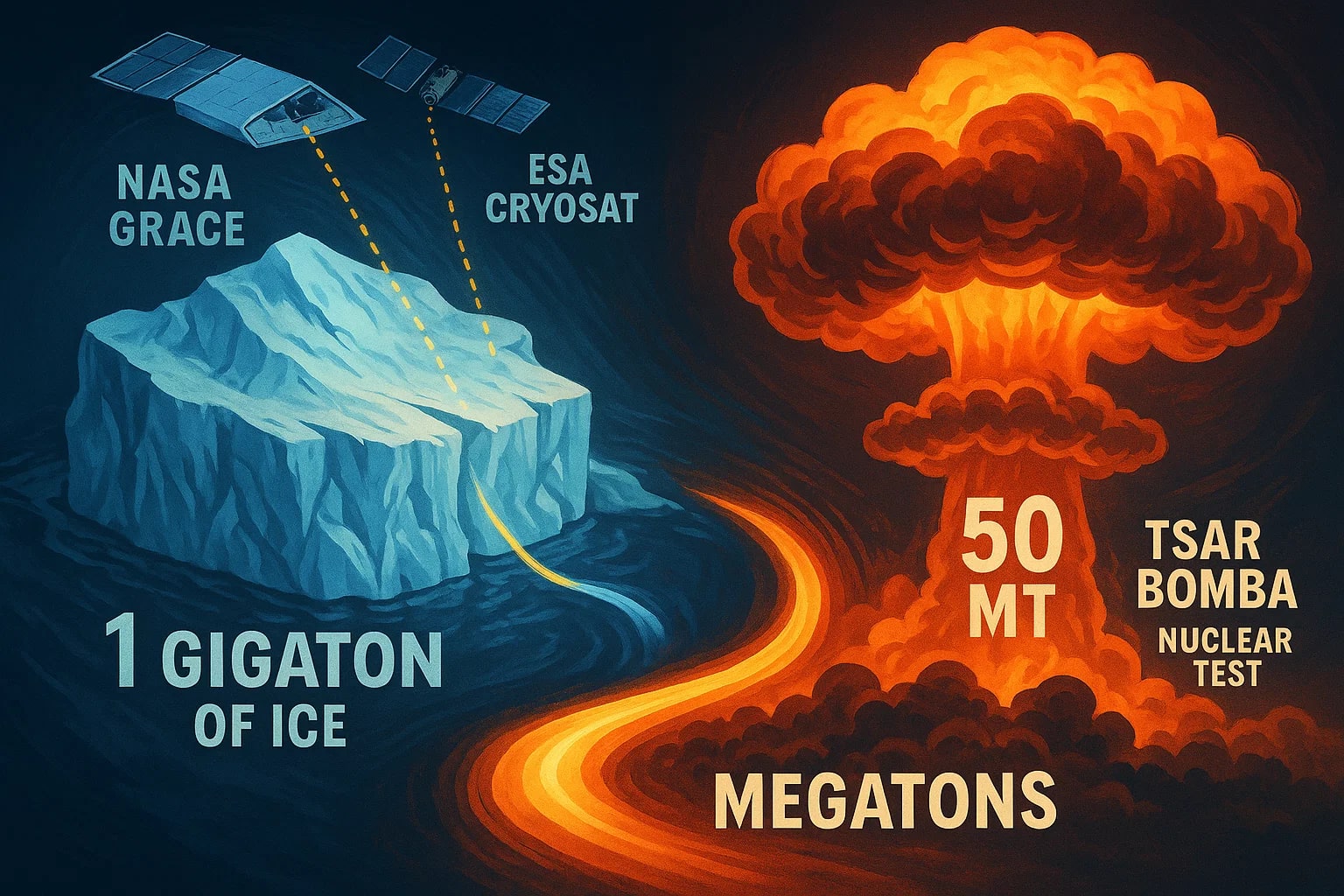Gigaton to Megaton – How to convert Gt to Mt
Gigatons and megatons help describe some of the largest masses on Earth — from polar ice loss to volcanic eruptions and even historical weapon yields. Both are part of the metric system, and their relationship is simple, but understanding where they appear brings real-world context to the numbers.

Gigaton: the scale of planetary change
A gigaton (Gt) equals one billion metric tons:
1 Gt = 1 000 Mt.
Climate scientists frequently use this unit to track ice sheet changes and carbon emissions. According to Nature (2019), satellite observations from NASA and ESA show the Greenland Ice Sheet lost around 280 Gt of ice per year between 2010 and 2018. These figures drive sea level rise models and global climate assessments.
Megaton: from materials to military history
A megaton (Mt) equals one million metric tons:
1 Mt = 1 000 000 t.
In environmental and industrial reporting, megatons describe annual fuel consumption, mining yields, or material exports. Historically, the term is also tied to nuclear weapon yields, expressed as megatons of TNT equivalent. The most powerful device ever tested, the Soviet Tsar Bomba (1961), yielded about 50 Mt, as documented by Rosatom archives and later reports to the United Nations.
Converting Gt to Mt
The conversion is straightforward because the units scale by a factor of 1 000:
1 Gt = 1 000 Mt
Mass (Mt) = Mass (Gt) × 1 000
Example calculation:
If Antarctica loses 150 Gt of ice in a year, that equals:
150 Gt × 1 000 = 150 000 Mt.
That’s 150 000 megatonnes of ice annually.
For other large-scale conversions, visit Conversion tools or the Weight & Mass Converter.
Did you know?
-
NASA’s GRACE satellite mission (2019) found Greenland lost about 3 800 Gt of ice between 2002–2019 — 3 800 000 Mt — contributing over 10 mm to global sea levels (Nature, 2019).
-
The Mount St. Helens eruption (1980) ejected roughly 1 Gt of material, or 1 000 Mt, according to U.S. Geological Survey data — a benchmark for volcanic events.
-
The Tsar Bomba detonation in 1961 produced an estimated 50 Mt of TNT equivalent, still the largest nuclear test ever (declassified Rosatom archive).
-
The IPCC 2022 report records fossil fuel CO₂ emissions at about 36 Gt annually, equal to 36 000 Mt, underscoring the magnitude of global energy use.
-
The 2011 Tōhoku earthquake off Japan released seismic energy comparable to 480 Mt of TNT (USGS data), illustrating how scientists use these magnitudes beyond mass.
When Gigatons Meet History and Science
Both gigatons and megatons show up in global datasets and world events, from slow-moving environmental changes to explosive historical moments.
In glaciology, missions like NASA’s GRACE and ESA’s CryoSat-2 rely on gigaton-level measurements to document how much ice sheets contribute to sea level rise. These figures often get converted into megatons to make yearly or regional totals easier to visualize, especially for policy discussions.
In 20th-century military history, megatons defined the nuclear arms race. The Tsar Bomba’s 50 Mt yield, tested over Novaya Zemlya in 1961, was about 1 500 times the combined power of the Hiroshima and Nagasaki bombs (as documented by the UN and Soviet archives). While never deployed, its scale became central to disarmament debates and international treaties.
From natural disasters to human-made detonations, these units help describe the extremes of our planet and our history.

Scaling Numbers for Clarity
Global-scale measurements and historic datasets often shift between Gt and Mt for readability. Climate research, geological surveys, and energy statistics may start in gigatons but move to megatons to align with industry standards or public reporting.
For precise conversions, Jetcalculator offers Conversion tools and a dedicated Weight & Mass Converter, so massive figures can be scaled without confusion.
Whether assessing ice loss, comparing volcanic eruptions, or analyzing historic tests, converting gigatons to megatons keeps extreme data organized and understandable.

